
95% of researchers rate our articles as excellent or good
Learn more about the work of our research integrity team to safeguard the quality of each article we publish.
Find out more
ORIGINAL RESEARCH article
Front. Mater. , 22 March 2019
Sec. Mechanics of Materials
Volume 6 - 2019 | https://doi.org/10.3389/fmats.2019.00040
This article is part of the Research Topic Multiscale lattices and composite materials: Optimal design, modeling and characterization View all 15 articles
The strength and stiffness of prestressed lattices, and their mechanical behavior, depend strongly on the underlying graph and the nodal conformation geometry. A special class of structures is that of superstable frameworks, that is, prestressed frameworks which are stable independently of material properties and level of prestress. After reviewing the main related notions and results in rigidity theory, we exploit the characterization of superstability for generic configurations to establish a construction for superstable systems on a given number of nodes generically placed in two or three dimensions.
The mechanical behavior of latticed structures is greatly affected by the properties of the underlying graph and the geometrical conformation of nodal positions. The simplest and most commonly adopted model is that of bar-and-joint framework, i.e., a graph together with a spatial placement of its vertices, or nodes. In Figure 1 different types of framework are shown (cf. e.g., Gortler et al., 2010; Connelly, 2013). If a set of edge lengths is compatible with a finite motion, then the framework is flexible (Figure 1A). When a framework is rigid at a given configuration, there is no other configuration close to it with same edge lengths (Figure 1B). If the edge lengths are compatible with just one configuration in d dimensions, then the framework is globally rigid (Figure 1C). If that configuration is unique even if embedded in a higher dimensional space, then the framework is universally rigid (Figure 1D).

Figure 1. Frameworks in two-dimensions belonging to different rigidity classes: flexible (A), rigid (B), globally rigid (C), and universally rigid (D).
A distinction can be made between generic configurations, those for which the nodal coordinates are algebraically independent, and nongeneric ones, which do not satisfy this condition (cf. e.g., Gortler et al., 2010; Connelly, 2013). As we will see in the next section, in case of a generic configuration on n nodes, the minimum number of edges required for universal rigidity is equal to e = dn − d(d + 1)/2 + 1, that is, e = 2n − 2 for d = 2 and e = 3n − 5 for d = 3.
Universal rigidity is strictly connected to superstability, the property of prestressed frameworks for which they are stable independently of the constitutive material properties and level of prestress. (Connelly, 1982; Zhang and Ohsaki, 2007; Micheletti, 2013). In particular, in the generic case, universal rigidity and superstability are equivalent (Connelly, 1982; Gortler and Thurston, 2014).
After reviewing the relevant notions and results in rigidity theory, we provide a specific construction to determine minimal generically universally rigid frameworks, i.e., generically universally rigid frameworks with the minimum number of edges, for an assigned set of nodal positions in two or three dimensions. The frameworks obtained with such a construction can be seen as a generalization of Grünbaum polygons (Figure 2) (Grünbaum and Shephard, 1978; Roth and Whiteley, 1981). In case of nongeneric configurations, it is possible to decrease the number of edges further (Figure 3); however, limited theoretical results are available for nongeneric systems, and we plan to consider this case in a future study. Our main results (Theorems 9 and 10) are presented in Section 3. Basic definitions and supporting results are reviewed in Section 2.

Figure 2. A Grünbaum polygon (A), and its nonconvex generalizations in two (B) and three dimensions (C). Center nodes and neighboring nodes (as defined in Section 3.1) are depicted in black and gray, respectively.
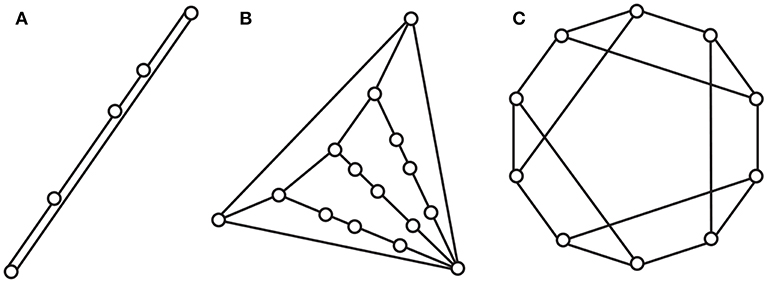
Figure 3. Examples of nongeneric minimal systems. All these frameworks have less than 2n − 2 edges and are universally rigid in two dimensions. In (A) all nodes need to stay aligned; (B) a cable net is attached to a triangle; (C) a system which we call Snelson polygon.
Different classes of rigidity can be defined for frameworks, and in each of them the generic and nongeneric cases can be distinguished. Prestressed (or prestressable) systems naturally comes into play when characterizing globally rigid and universally rigid frameworks. In writing the present section, we borrowed some of the notation, terminology, and examples from the cited literature and in particular from Connelly (2013) and Gortler et al. (2010).
Let Ed be the d-dimensional Euclidean space and Vd the associated vector space. A graph is given by a set of n nodes together with a set of e edges connecting pairs of‘ nodes. The edge connecting nodes is denoted by . Graphs are finite and undirected, without loops or multiple edges. A configuration in Ed for the graph is an assignment of a position vector to each node , so that a corresponding point is determined by its position with respect to a chosen origin O ∈ Ed. We denote by p ∈ Vnd the vector grouping all nodal position vectors. A framework is given by a graph together with a configuration, that is, is a framework with graph and configuration p.
Associated to a framework is the set of the half-squared edge-lengths,
A configuration q is admissible for if . Two configurations p and q are congruent, and we write p ≡ q, if |pi − pj| = |qi − qj| for every choice of i and j in . Equivalently, two configurations are congruent if they differ by an isometry of Ed, i.e., a composition of translations, rotations and reflections. A framework is rigid if there is an ε > 0 such that any other admissible configuration q for which |p−q| < ε is congruent to p.
The jacobian of , which is an e-by-dn matrix, is the rigidity matrix, R. A framework is infinitesimally rigid if the rank of R is equal to nd − d(d + 1)/2, or equivalently, if the only solutions to the system of equations Rṗ = 0 are rigid velocities, i.e., nodal velocities in a rigid motion (Figure 4). For example, the equation corresponding to the edge ij in this system is given by
which is obtained by setting equal to zero the first derivative of λij. The solutions of Rṗ = 0 which are not rigid velocities are called mechanisms.
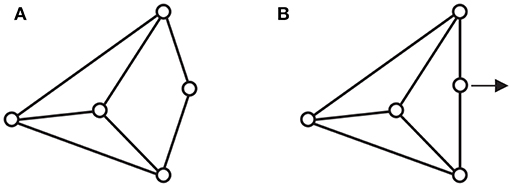
Figure 4. An infinitesimally rigid framework (A) and a rigid framework which is not infinitesimally rigid (b). The horizontal nodal velocity vector shown in (B), when all the other nodes are fixed, cause null changes in length but it is not a rigid velocity.
A framework is globally rigid if any admissible configuration q is congruent to p (Figure 5). A framework is universally rigid if it is globally rigid in all dimensions (Figure 6). Universal rigidity implies global rigidity, which implies infinitesimal rigidity, which implies rigidity.
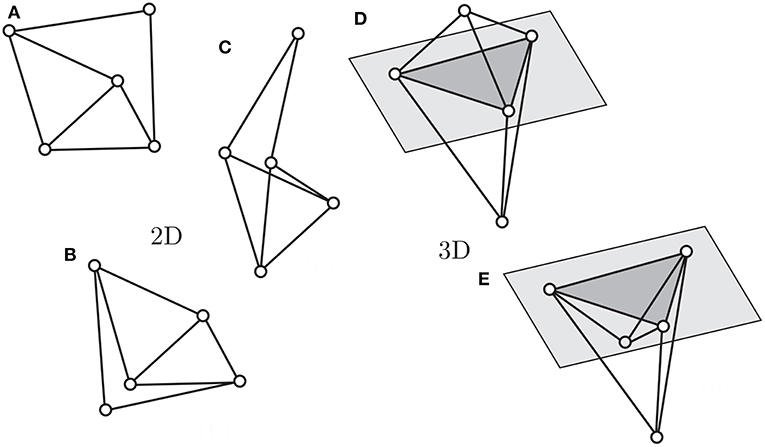
Figure 5. The rigid frameworks (A), in two dimensions, and (D), in three dimensions, are not globally rigid: there exist more than one non-congruent admissible configurations, for example, (B,C) for (A), and (E) for (D).
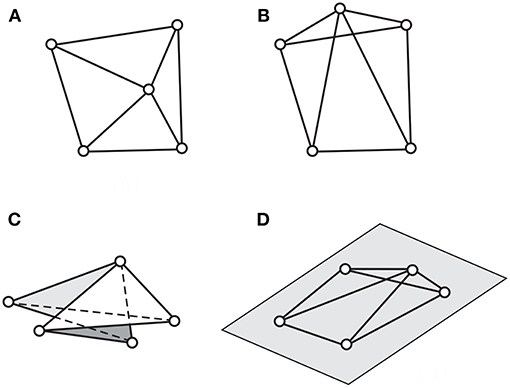
Figure 6. Globally rigid (A) and universally rigid (B) frameworks. When these are considered in three dimensions, the framework (A) can flex out of plane, as in (C), the one in (B) can only stay in a plane (D).
A configuration is generic if the coordinates in p are algebraically independent over the integers, i.e., if the nodal coordinates do not satisfy any nontrivial polynomial equation with integer coefficients. Intuitively, if the configuration is nongeneric, then it is special in some way. For example the framework in Figure 7A is globally rigid, while the one in Figure 7B, where three nodes are aligned on a diagonal, is not. Another example is given in Figure 4, with configurations Figures 4A,B being respectively generic and nongeneric.

Figure 7. globally rigid framework (A), which loses this property in the nongeneric configuration (B), where three nodes are aligned on a diagonal. For the latter framework the configuration (C) is also possible.
A framework is generically rigid if it is rigid and p is generic. Rigidity is a generic property, i.e., it is a property of the graph, not the configuration: if a framework is rigid at a generic configuration then it is rigid at every other generic configuration. Moreover, at generic configurations, rigidity and infinitesimal rigidity are equivalent.
The minimum number of edges necessary for generic rigidity are 2n − 3 in 2D and 3n − 6 in 3D. Intuitively, in 2D, we can start with an edge connecting two nodes, then iteratively adding one node connected to the other nodes by two noncollinear edges. In 3D, we can start with a nondegenerate triangle (three vertices and three edges), then iteratively adding one tripod, i.e., a node connected to the other nodes by three noncoplanar edges. These constructions constitute particular Henneberg sequences (Eren et al., 2004b): sequences of operations which preserve minimal generic rigidity.
The characterization of global rigidity has been given in the literature in terms of stress. A stress ω is an assignment of a real number ωij to each edge ij of the framework. A selfstress for is a stress satisfying at every node i the nodal equilibrium equation
where the summation is extended to every node j connected to node i by an edge. The equilibrium equations can be written in matrix form as
with A the dn-by-e equilibrium matrix. Selfstresses belong to the nullspace of the equilibrium matrix. One classic result is that A = RT, so that the number of independent selfstresses s and mechanisms m are related to n and e by the following rule
where d(d + 1)/2 is the number of independent rigid motions in Ed. This rule follows from the orthogonality of the fundamental subspaces (nullspace and image of the transposed) of R and A.
A fundamental object is the stress matrix, Ω, a n-by-n matrix whose entries are defined as follows:
where ω is a selfstress. The stress matrix is equal to the weighted Laplacian of the graph, with weights given by the selfstress values on the edges. Notice that the weights can be either positive or negative, so that classic results on positively-weighted Laplacians do not apply.
A useful characterization has been given as follows (Connelly, 1982, 2013). A framework in Ed with the affine span of p1, …, pn being all Ed and a nonzero selfstress is superstable if the following conditions hold:
1. Ω is positive semidefinite;
2. Ω has rank n − d − 1;
3. there are no affine admissible motions.
Theorem 1. Connelly (1982), see also Connelly (2013) A superstable framework is universally rigid.
Condition (1) implies that if there is another admissible configuration, then it has the same selfstress; condition (2) then implies that this other configuration is an affine image of the original one, and condition (3) implies that the affine image is actually congruent to the original configuration (cf. Figure 8). A particular class of superstable frameworks is that of cablenets, i.e., externally anchored frameworks where each edge has positive stress (Figure 9A).

Figure 8. This framework for d = 3 satisfies conditions (1) and (2), but not condition (3) of Theorem 1, there is an affine motion changing the angle between the highlighted planes, preserving all bar lengths.
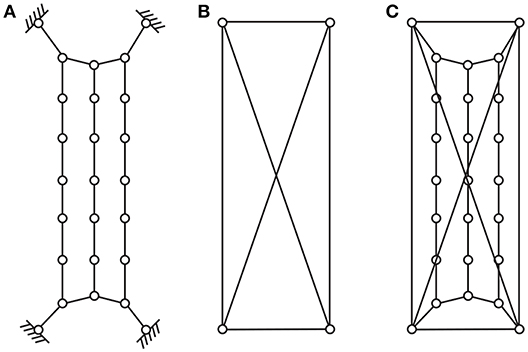
Figure 9. A cablenet (A) can be anchored to a universally rigid framework (B) to obtain another universally rigid framework (C).
Now we turn to generic configurations. A simplex in Ed is a framework on the complete graph on d + 1 nodes, e.g., triangles in E2 or tetrahedra in E3. Simplices (and all frameworks on complete graphs) are universally rigid by definition, since admissible configurations must be congruent to each other. Every generic globally rigid framework in Ed which is not a simplex (i.e., it has at least d + 2 nodes) admits at least one independent selfstress. This follows from the next theorem. A framework is redundantly rigid if it is rigid after the removal of an edge. A graph is c-connected if at least c nodes have to be removed from the graph to disconnect it.
Theorem 2. Hendrickson (1992). If a framework with n ≥ d + 2 is generically globally rigid in Ed then it is redundantly rigid and (d + 1)-connected.
For d = 2 the theorem holds with an “if and only if” condition (Berg and Jordan, 2003, cf Connelly, 2013). Since generic redundant rigidity implies that there exist at least a selfstress, s ≥ 0 and that there are no mechanisms, m = 0, it follows from (1) that in a generically globally rigid framework the number of edges is equal to or higher than
e.g., 2n − 2 in 2D or 3n − 5 in 3D.
A complete characterization of generic global rigidity has been given in the following theorem.
Theorem 3. A framework with n ≥ d + 2 is generically globally rigid in Ed if and only if there is a nonzero selfstress whose stress matrix has rank n − d − 1.
The “if” part is due to Connelly (1982), the “only if” part to Gortler et al. (2010).
The next theorem provide the converse of Theorem 1 in the generic case.
Theorem 4. Gortler and Thurston (2014). A universally rigid framework with p generic and n ≥ d + 2 is superstable.
It is worth noticing that while global rigidity is a generic property, universal rigidity is not: if framework is universally rigid in a certain generic configuration, it can lose this property in a different generic configuration (compare cases (c) and (d) in Figure 1).
A less strict condition consists in requiring a configuration to be general. A configuration in Ed is general if no d + 1 nodes are affinely dependent, e.g., there are no three collinear nodes in d = 2, or there are no three collinear nodes and no four coplanar nodes in d = 3. In this case we have the following result.
Theorem 5. Alfakih and Ye (2013). A framework with p general and n ≥ d + 2 is universally rigid if there is a nonzero selfstress whose stress matrix is positive semi-definite with rank n − d − 1.
It has been shown in Alfakih et al. (2013) that the converse of this theorem holds for (d + 1)-lateration graphs, i.e., graphs obtained from a simplex by applying a sequence of (d + 1)-valent node additions, i.e., the addition of a node connected by d + 1 edges to the other nodes. An analogous result regarding global rigidity has been obtained previously in Anderson et al. (2006). The number of edges of frameworks obtained in this way is
that is e = 3n − 6 for d = 2 and e = 4n − 10 for d = 3.
For n large, these values of e are 50% and 33% higher than the minimum value given by (2), respectively for d = 2 and d = 3.
By considering frameworks with a stress, the notion of tensegrity framework naturally comes into play. Indeed, many results have been first obtained for tensegrity frameworks, and then applied to the particular case of bar-frameworks.
A tensegrity framework is a framework where each edge can be labeled as a bar, a cable, or a strut: bars cannot change length, cables cannot increase in length, and struts cannot decrease in length. It turns out that a tensegrity framework is globally/universally rigid if the corresponding bar-framework is and the stress is proper, that is, cables have positive stress, and struts negative (Connelly, 2013). In other words, there is no difference between a bar-framework with a stress satisfying the theorems above and a tensegrity framework, with same graph and configuration, whose edges are labeled accordingly: cables if the stress is positive, struts if the stress is negative. Bars can be placed anywhere.
We conclude this section by reporting three results about known classes of frameworks. The first one is about convex polygons.
Theorem 6. (Tensegrity polygons, Connelly, 1982). A tensegrity framework with the shape of a convex polygon, with cables on the outside, struts inside, and a proper a selfstress, is universally rigid (Figure 10).

Figure 10. Polygons satisfying Theorem 6: (A) a Grünbaum polygon; (B) a Cauchy polygon; (C) a Snelson polygon. Thin and thick lines corresponds respectively to cables and struts.
In the next section we will focus on the polygons like those in Figures 2A, 10A, first described by Grünbaum and Shephard (1978).
The second result is about three-dimensional frameworks.
Theorem 7. (Central symmetric tensegrity polyhedra, Lovász, 2001; Bezdek and Connelly, 2006). Every tensegrity framework with the shape of a centrally symmetric polyhedron, with cables outside, bars connecting diametrically opposite pairs of vertices, and a proper selfstress, is universally rigid (Figure 11).
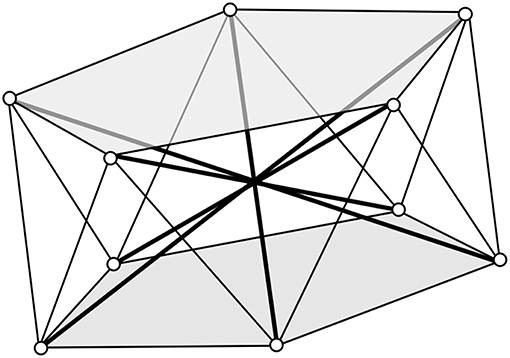
Figure 11. A centrally symmetric framework with the shape of a pentagonal antiprism (with highlighted bases), see Theorem 7.
The third result is about combining different frameworks together.
Theorem 8. (Attachments, Ratmanski, 2010). Given two universally rigid frameworks in general position, it is possible to combine them into a universally rigid assembly if they have d + 1 nodes in common.
Analogous results for globally rigid frameworks are presented in Eren et al. (2004a) and Connelly (2011).
In this section we show that it is always possible to construct frameworks on n given nodes in E2 or E3 with the minimum number of edges (2), irrespective of the generic/nongeneric property of the configuration. Such frameworks belong to a new class which generalizes that of Grünbaum polygons (Grünbaum and Shephard, 1978).
Grünbaum polygons are frameworks obtained by placing nodes and edges at the vertices and the sides of a convex polygon, then by choosing one node, the center node (in black in Figure 2A), and by connecting all the other nodes to it with an edge, except the two neighboring nodes (in gray in Figure 2A). The construction is completed by adding one edge connecting the two neighboring nodes.
We provide here a similar construction to assign (2n − 2) edges to a given a set of nodes in E2 in order to obtain a universally rigid framework. We will call the resulting framework a nonconvex Grünbaum polygon (Figure 12).
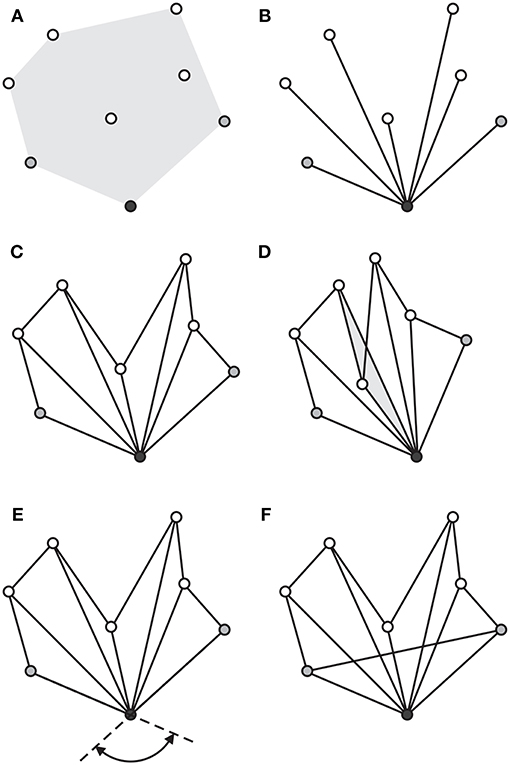
Figure 12. Construction of a nonconvex Grünbaum polygon starting from a set of points in 2D: (A) three nodes corresponding to three consecutive vertices on the boundary of the convex hull of the set, the middle node is the center (in black), the other two nodes are its neighbors (in gray); (B) all the nodes are connected to the center by edges; (C) edges added to form adjacent triangles, so as to obtain a fan; (D) one of the admissible configurations of this fan, obtained by reversing the triangle shown (in light gray); (E) the completely unfolded configuration of the fan maximize the angle shown; (F) universal rigidity is obtained by adding the last edge between the two neighbors of the center.
First, the convex hull of the nodes is constructed and three consecutive vertices on its boundary coinciding with three nodes are chosen (Figure 12A), the middle one becomes the center to which all the other nodes are connected (Figure 12B). Then, additional edges are added to form a contiguous sequence of triangles sharing the center as a vertex (Figure 12C), plus the last edge connecting the two neighboring nodes (Figure 12F).
Theorem 9. Every nonconvex Grünbaum polygon is universally rigid.
Proof. Up to the addition of the last edge, the framework can be viewed as forming a kind of fan shape which “unfold” from the center node (Figure 12C). This incomplete framework admits a number of configurations equal to 2f, where f is the number of internal edges or folds of the fan (Figure 12D). The distance between the two neighboring nodes will reach a maximum only when the fan is completely unfolded. It follows that by adding the last edge between the two neighboring nodes, the unfolded configuration is unique.
By embedding this framework in a higher dimensional Euclidean space, the situation does not change. Since each triangle of a fan is universally rigid by itself and it can only rotate about a fold, relative to its neighboring triangles, the triangle inequality ensure that the distance between the two neighboring nodes has a global maximum when the fan is flat, therefore the Grümbaum polygon is universally rigid. □
Notice that this proof is valid for both convex and nonconvex Grünbaum polygons. Notice also that the construction works even if the center is aligned with its neighbors, or if two or more fold are collinear. The result holds even if the configuration is nongeneric, the main requirement being that the center and its neighbors are on the boundary of the convex hull.
In three dimensions we can obtain a perfectly analogous result for assigning (3n − 5) edges red to a given set of nodes in E3. We construct the convex hull of this set. There will be at least four vertices of the hull forming two adjacent triangles, sharing one edge of the convex hull. The shared edge is the central edge of the framework, the two nodes on this edge are the central nodes, while the other two are the neighboring nodes. Now, we can add edges connecting each of the neighboring nodes to the central nodes. We do the same with the remaining nodes, by connecting them to the central nodes. In this way, we obtain a set of triangles in space, all sharing one edge (Figure 13A). Then, for each couple of neighboring triangles, we add an edge between the nodes so as to form a tetrahedron. Finally, the last edge of this construction is added between the two neighboring nodes (Figure 13B).
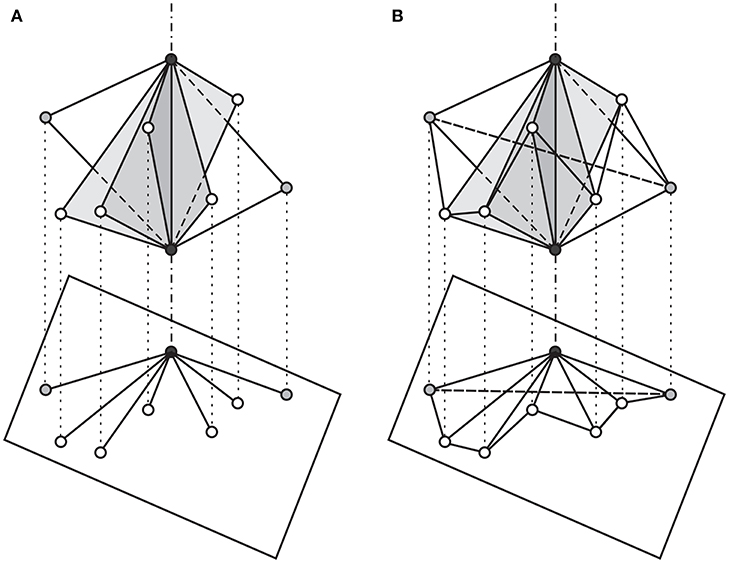
Figure 13. Two phases, (A) and (B), of the Construction of a three-dimensional Grünbaum framework, and the corresponding projection onto a nonconvex Grünbaum polygon (see description in Section 3.2).
An easy way of visualizing this framework is to project it along the direction of the central edge onto a plane, resulting in a fan-like framework, a nonconvex Grünbaum polygon. Similarly to what we have done before, we can consider the incomplete framework obtained by removing the last edge and argue that this admits a number of configuration equal to 2f, with f defined for the projected framework as in the two-dimensional case. Among all these configurations, the one which is completely “unfolded” gives the maximum distance between the neighboring nodes, still using this term in analogy with the two-dimensional case. Once we add the last edge in this configuration, we obtain a globally rigid structure, which, by the triangle inequality is also universally rigid. We call frameworks obtained in this way 3D Grünbaum framework and state the following theorem.
Theorem 10. Every 3D Grünbaum framework is universally rigid.
Notice that we can view these kind of frameworks, both in 2D and in 3D, as obtained by anchoring the nodes to a simplex, in the same way as we can anchor a cable-net to a (universally) rigid structure (Figure 9).
Notice also that we can find other generalized Grünbaum frameworks. For example, the one shown in Figure 14 (top right) has two centers, corresponding to two fans with one side in common. It is easy to see that, in order for multiple-fans frameworks to be universally rigid the centers should be on opposite sides of the edge connecting the neighbors. Analogous constructions exist also in three dimensions (Figure 14, bottom right).
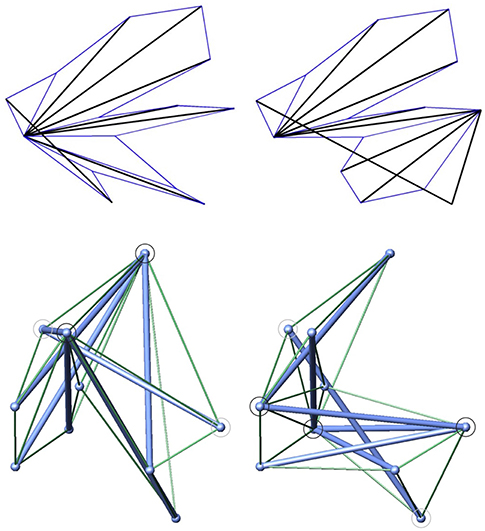
Figure 14. (Top) Two universally rigid frameworks obtained from the same randomly generated nodal positions in E2. The one on the top right is composed of two fans. Thin and thick edges correspond respectively to positive and negative stresses. (Bottom) Two constructions for the same randomly generated nodal positions in E3. The one on the bottom right is composed by two fans. Black circles locate the central edges, gray circles locate the neighboring nodes. Thin and thick edges correspond respectively to positive and negative stresses.
In Figure 15 we present two examples of application of Theorems 9, 10 in combination with Theorem 8. These examples shows how to avoid the occurrence of bars of excessive length by considering modular frameworks. In Figure 15 (top), a universally rigid framework in E2 is obtained by repetition of a universally rigid module, with adjacent modules having three nodes in common. In Figure 15 (bottom), a universally rigid framework on randomly generated nodal positions in E3 is composed by three universally rigid subframeworks, each sharing four nodes with the adjacent one. Space-filling universally rigid assemblies can be obtained in analogous fashion.
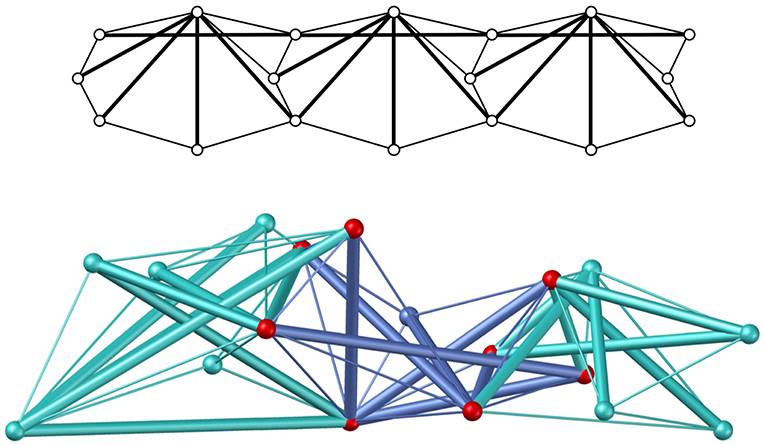
Figure 15. (Top) A modular universally rigid framework in E2 obtained by repetition of a universally rigid module. (Bottom) Construction of a modular universally rigid framework in E3 for randomly generated nodal positions. The framework is composed by three universally rigid subframeworks (depicted in different color), each sharing four nodes with the adjacent one.
After reviewing the main concepts and results in rigidity theory, we have given a construction for generic universally rigid frameworks in two and three dimensions with the minimum number of edges, with a significant improvement over existing methods. All together, these notions provide a set of useful tools that engineers can use to design superstable structural and mechanical systems, with guaranteed strength and stiffness properties. Additional applications include sensor networks, multi-agent systems, and protein conformation analysis. Our constructions relies on the computation of the convex hull of the set of nodes, a relatively quick operation, even if performed dynamically, i.e., if nodes are sequentially added and removed (see Hert and Schirra, 2018). For nongeneric configurations the number of edges can be further reduced, with the limitation that any change of configuration must happen on a lower-dimensional nongeneric manifold. The problem of constructing minimal nongeneric universally rigid frameworks will be the subject of future work.
SK and AM contributed conception and design of the study. All authors contributed to developing the study, wrote sections of the manuscript, revised it, read and approved the submitted version.
AM gratefully acknowledges the financial support from the Italian Ministry of Education, University, and Research (MIUR) under the FFABR grant L.232/2016.
The authors declare that the research was conducted in the absence of any commercial or financial relationships that could be construed as a potential conflict of interest.
An earlier version of this work appeared in the preprint (Kelly and Micheletti, 2014) uploaded in the arXiv repository.
Alfakih, A. Y., Taheri, N., and Ye, Y. (2013). On stress matrices of (d + 1)-lateration frameworks in general position. Math. Programming 137, 1–17. doi: 10.1007/s10107-011-0480-0
Alfakih, A. Y., and Ye, Y. (2013). On affine motions and bar frameworks in general positions. Lin. Algeb. Applic. 438, 31–36. doi: 10.1016/j.laa.2012.08.031
Anderson, B. D. O., Belhumeur, P. N., Eren, T., Goldenberg, D. K., Morse, A. S., Whiteley, W., et al. (2006). Graphical properties of easily localizable sensor networks. J. Wirel. Netw. 15, 177–191. doi: 10.1007/s11276-007-0034-9
Berg, A., and Jordan, T. (2003). A proof of connelly's conjecture on 3-connected circuits of the rigidity matroid. J. Combin. Theory Ser. B. 88, 77–97. doi: 10.1016/S0095-8956(02)00037-0
Bezdek, K., and Connelly, R. (2006). Stress matrices and m matrices. Oberwolfach Rep. 3, 678–680. doi: 10.4171/OWR/2006/12
Connelly, R. (2011). “Combining globally rigid frameworks,” in Classical and Modern Mathematics in the Wake of Boris Nikolaevich Delone (Moscow: MAIK Nauka/Interperiodica).
Connelly, R. (2013). “Tensegrities and global rigidity,” in Shaping Space, ed M. Senechal (New York, NY: Springer), 267–278. doi: 10.1007/978-0-387-92714-5_21
Eren, T., Anderson, B. D. O., Whiteley, W., Morse, A. S., and Belhumeur, P. N. (2004a). “Merging globally rigid formations of mobile autonomous agents,” in AAMAS '04 Third International Joint Conference on Autonomous Agents and Multiagent Systems, Vol. 3, (Washington, DC; New York, NY: IEEE Computer Society), 1260–1261
Eren, T., Andreson, B. D. O., Morse, A. S., Whiteley, W., and Belhumeur, P. N. (2004b). Operations on rigid formations of autonomous agents. Commun. Inform. Syst. 3, 223–258. doi: 10.4310/CIS.2003.v3.n4.a2
Gortler, S. J., Healy, A. D., and Thurston, D. P. (2010). Characterizing generic global rigidity. Am. J. Math. 132, 897–939. doi: 10.1353/ajm.0.0132
Gortler, S. J., and Thurston, D. P. (2014). Characterizing the universal rigidity of generic frameworks. Disc. Comput. Geom. 51, 1017–1036. doi: 10.1007/s00454-014-9590-9
Grünbaum, B., and Shephard, G. C. (1978). Lectures on Lost Mathematics. Lecture notes. Syracuse, NY: Syracuse University.
Hendrickson, B. (1992). Conditions for unique graph realizations. SIAM J. Comput. 21, 65–84. doi: 10.1137/0221008
Hert, S., and Schirra, S. (2018). “3D convex hulls,” in CGAL User and Reference Manual, 4.13 Edn (CGAL Editorial Board).
Kelly, S. D., and Micheletti, A. (2014). A class of minimal generically universally rigid frameworks. arXiv:1412.3436v1.
Lovász, L. (2001). Steinitz representations of polyhedra and the Colin de Verdiére number. J. Combinat. Theory Ser. B 82, 223–236. doi: 10.1006/jctb.2000.2027
Micheletti, A. (2013). “Bistable regimes in an elastic tensegrity structure,” Proceedings of the Royal Society A, Vol. 469.
Roth, B., and Whiteley, W. (1981). Tensegrity frameworks. Trans. Am. Math. Soc. 265, 419–446. doi: 10.1090/S0002-9947-1981-0610958-6
Keywords: universal rigidity, superstability, generic configuration, Grünbaum polygon, tensegrity frameworks
Citation: Kelly SD, Micheletti A and Tiero A (2019) On the Design of Superstable Prestressed Frameworks. Front. Mater. 6:40. doi: 10.3389/fmats.2019.00040
Received: 12 December 2018; Accepted: 20 February 2019;
Published: 22 March 2019.
Edited by:
Chiara Daraio, California Institute of Technology, United StatesReviewed by:
Francesco Dal Corso, University of Trento, ItalyCopyright © 2019 Kelly, Micheletti and Tiero. This is an open-access article distributed under the terms of the Creative Commons Attribution License (CC BY). The use, distribution or reproduction in other forums is permitted, provided the original author(s) and the copyright owner(s) are credited and that the original publication in this journal is cited, in accordance with accepted academic practice. No use, distribution or reproduction is permitted which does not comply with these terms.
*Correspondence: Andrea Micheletti, bWljaGVsZXR0aUBpbmcudW5pcm9tYTIuaXQ=
Disclaimer: All claims expressed in this article are solely those of the authors and do not necessarily represent those of their affiliated organizations, or those of the publisher, the editors and the reviewers. Any product that may be evaluated in this article or claim that may be made by its manufacturer is not guaranteed or endorsed by the publisher.
Research integrity at Frontiers

Learn more about the work of our research integrity team to safeguard the quality of each article we publish.